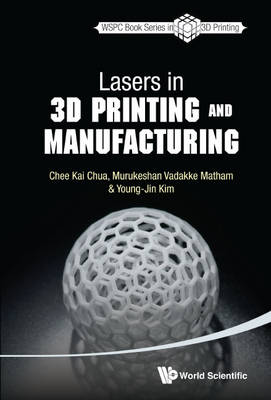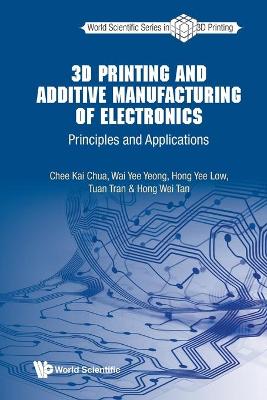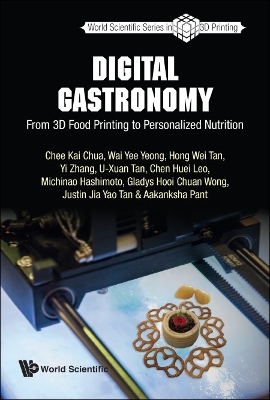World Scientific Series In 3d Printing
3 primary works
Book 2
Lasers In 3d Printing And Manufacturing
by Chee Kai Chua, Murukeshan Vadakke Matham, and Young-jin Kim
Published 23 February 2017
Additive Manufacturing (AM), popularly known as 3D printing, is playing an increasingly significant role in the manufacturing arena. AM has revolutionized how prototypes are to be made and small batch manufacturing should be carried out. Due to high flexibility and high efficiency of lasers, laser-assisted Manufacturing (LAM) and AM technologies are recently getting much attention over traditional methods.This textbook is a timely information resource for undergraduates, postgraduates and researchers who are interested in this emerging technology. The book will cover the basics of lasers, optics and materials used for manufacturing and 3D printing. It will also include several case studies for readers to apply their understanding of the topics, provide sufficient theoretical background and insights to today's key laser-assisted AM processes and conclude with the future prospects of this exciting technology.This is the first textbook tailored specifically for Lasers in 3D Printing and Manufacturing with detailed explanations. The book will focus on laser-assisted 3D printing and Additive Manufacturing (AM) from basic principles of lasers, optics and AM materials to advanced AM technologies, including in-depth discussion on critical aspects throughout the laser-assisted AM processes, such as optical system design, laser-material interaction and laser parameters' optimization.
Book 3
3d Printing And Additive Manufacturing Of Electronics: Principles And Applications
by Chee Kai Chua, Wai Yee Yeong, Hong Yee Low, Tuan Tran, and Hong Wei Tan
Published 21 May 2021
3D printed electronics have captured much attention in recent years, owing to their success in allowing on-demand fabrication of highly-customisable electronics on a wide variety of substrates and conformal surfaces. This textbook helps readers understand and gain valuable insights into 3D printed electronics. It does not require readers to have any prior knowledge on the subject.3D Printing and Additive Manufacturing of Electronics: Principles and Applications provides a comprehensive overview of the recent progress and discusses the fundamentals of the 3D printed electronics technologies, their respective advantages, shortcomings and potential applications. The book covers conventional contact printing techniques for printed electronics, 3D electronics printing techniques, materials and inks inks for 3D-printed electronics, substrates and processing for 3D-printed electronics, sintering techniques for metallic nanoparticle inks, designs and simulations, applications of 3D-printed electronics, and future trends. The book includes several related problems for the reader to test his or her understanding of the topics.This book is a good guide for anyone who is interested in the 3D printing of electronics. The book is also an effective textbook for undergraduate and graduate courses that aim to arm their students with a thorough understanding of the fundamentals of 3D printed electronics.Related Link(s)
Book 4
Digital Gastronomy: From 3d Food Printing To Personalized Nutrition
by Chee Kai Chua, Justin Jia Yao Tan, Gladys Hooi Chuan Wong, Michinao Hashimoto, Chen Huei Leo, U-xuan Tan, Yi Zhang, Hong Wei Tan, Wai Yee Yeong, and Aakanksha Pant
Published 31 January 2023
The food industry has seen many changes over the last several decades - new technologies have been introduced into the way we cook, manufacture, and present food products to consumers. Digital gastronomy, which combines new computational abilities such as three-dimensional (3D) printing with traditional food preparation, has allowed consumers to design and manufacture food with personalized shapes, colours, textures and even nutrition. In addition to the personalisation of food, 3D printing of food has other advantages such as promoting automation in food preparation and food sustainability through 3D-printed cell-based meats and alternative proteins. Entire meals can be constructed just by 3D food printing alone.In this textbook, the background, principles, commercial food printers, materials, regulations, business development, as well as the emerging technologies and future outlook of 3D food printing are explored. In terms of 3D-printed materials, four main classes, are reviewed: namely, desserts / snacks (comprising of dairy products, chocolate, sugars, and dough), fruits / vegetables, meats /alternative proteins, and pharmaceuticals / nutraceuticals.This textbook has been written to offer readers keen to learn more about 3D food printing in terms of concepts, processes, applications, and developments of 3D food printing. No prior knowledge is required. At the end of each chapter, a set of problems offer undergraduate and postgraduate students with practice on the main ideas discussed within the chapter. For tertiary-level lecturers and university professors, the topic on 3D food printing can be associated to other subjects in food and nutrition, pharmaceutical and nutraceutical sciences and food engineering.


